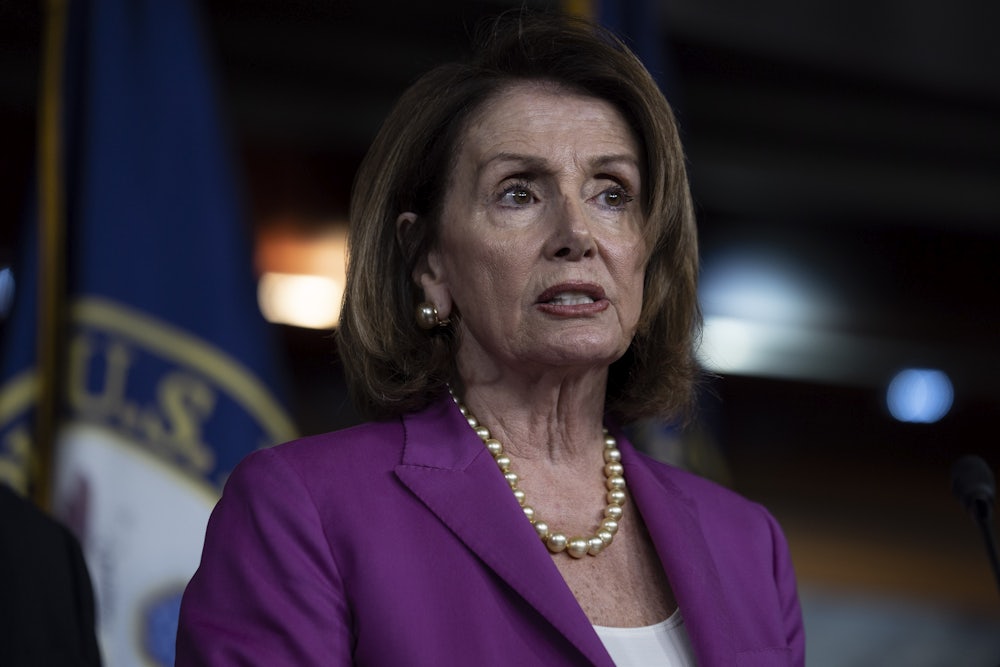In 2006, just before Nancy Pelosi became speaker of the House of Representatives, Republican strategist Dan Schnur told NPR that “if you’re a Republican trying to warn voters against a Democratic vote, even for one of these more moderate candidates, you can say ‘San Francisco values,’ you can mention Nancy Pelosi, and the point you can make in almost a verbal shorthand is to say, ‘Hey, look, these are tax-raising, terrorist-loving, same-sex marriage supporting, ultra-liberal Democrats who aren’t like you and me.’”
So it’s been for the last 12 years. Pelosi’s name has become a shibboleth, brandished in countless Republican attack ads against Democratic candidates for the House. This year, ahead of the fall midterms, the strategy has only intensified. As USA Today reported in April, a third of all GOP broadcast ads for House races this year featured the Democratic leader—up from 9 percent in 2016 and 13 percent in 2014.
Some Democrats fear the strategy is working, costing the party votes and possibly endangering the predicted “blue wave” in November. “People pretend that it isn’t a problem, but it’s a problem that exists,” Representative Brian Higgins, a New York Democrat, told The Washington Post. Even if Democrats still win the House, Republican consultant Ken Spain said, “it could be the difference between having a razor-thin majority and a governing majority. It’s a lot easier to move legislation when you have a cushion of votes to work with.”
To move House legislation, of course, the party will need a House leader. But it’s not clear, amid a growing mutiny, that Pelosi will retain the position she’s held for the past dozen years—nor is there a clear alternative. That’s why the real Pelosi conundrum for Democrats isn’t on the campaign trail; it’s in the House come January.
The midterms are still a few months away, but the signs are promising for the opposition party. Democratic turnout is up. According to recent polls, voters prefer Democrats in Congress over Republicans—even in deeply conservative regions like western Virginia. In generic congressional ballots, Democrats currently lead Republicans by an average of 5 points, and new candidates have either upset Republicans in historically red districts or at least closed wide gaps.
While the party regains its footing in the Trump era, though, its leadership seems less certain. NBC News reported last week that over 50 Democratic candidates have declined to back Pelosi’s continued leadership. Among the rank-and-file, anti-Pelosi sentiment seems even stronger. About half of Democratic voters say they’d support a new party leader over Pelosi.
This opposition to Pelosi’s leadership did not appear overnight. Dissent has grown slowly for years, and it now seems to unite the party’s left and moderate wings. Left-wing candidates tend to oppose Pelosi because they find her fearsome “San Francisco values” not very far to the left at all. In 2016, she rejected Senator Bernie Sanders’s suggestion that the government could raise taxes to pay for his social welfare policies. And in 2017, she declined to endorse Sanders’s single-payer health care bill. In its 2017 report card on Congress, the website GovTrack ranked Pelosi as the 37th most conservative House Democrat, out of 197.
Pelosi might be a more natural ally to moderate Democrats, but lately they aren’t interested in her support, either. Pennsylvania’s Conor Lamb disavowed Pelosi during his successful campaign for the House; so did Danny O’Connor, who nearly achieved an upset victory in Ohio’s 12th congressional district. The one challenge to Pelosi’s leadership has also come from the party’s moderate wing. Ohio Representative Tim Ryan unsuccessfully ran against Pelosi for the party’s leadership in 2016, but re-emerged recently as a possible successor: Politico reported last month that Ryan is privately considering another challenge.
While left-wing and moderate Democrats seem unified in their disdain for Pelosi, there is no clear unity candidate to replace her as leader. Ryan, who won the support of one third of the Democratic caucus in 2016, might be able to unify the party’s center and center-right. His views have evolved during his time in office—he no longer opposes abortion rights, for example, and he supports Medicare for All—but he is still a moderate. He recently told Politico that he “would not be mad” if the outlet said that he considered himself a younger version of former Vice President Joe Biden. (He ranks 60th on that GovTrack list.)
A Ryan leadership might spare candidates targeted by the GOP (“Youngstown values” doesn’t have the same ring as “San Francisco values”), but he’s not likely to get support from left-wing Democrats. “You’re not going to make me hate somebody just because they’re rich. I want to be rich!” Ryan joked recently at a conference held by Third Way, the centrist think tank. Rashida Tlaib and Alexandria Ocasio-Cortez, two democratic socialists who are almost certain to enter the House this fall, probably don’t see the humor in Ryan’s remarks. Many Democratic voters might not either, given evidence that the party’s base now views socialism more favorably than capitalism.
But left-wing Democrats don’t have an obvious alternative to Ryan, which points to the real problem with Pelosi. “They come after me because I’m effective,” Pelosi told Rolling Stone in July. She was referring to Republicans, but could well have been referring to Democrats, too. Her skill as a parliamentarian is unquestionable, as when she shepherded the Affordable Care Act through a fractious Congress. She’s also an accomplished fundraiser for her colleagues. She is effective, which is partly why she’s been a congresswoman since 1987 and has steered the party since 2006. But while Pelosi and her fellow leaders held onto power, the party’s backbench has withered. Now, the backbench is rising up—with enough votes to boot Pelosi from power, but not enough to elevate a new leader.
Is Pelosi still “worth the trouble,” as she puts it? Democrats won’t know for sure until next year, but her tenure is certainly in doubt.
